Your Guide To 8 Different Types of Doors
With so many door styles available today, it can be challenging to identify them all, let alone understand their unique functions or aesthetic benefits.
With many years of expertise in replacement doors, we’ve developed an extensive knowledge base, making us the perfect guide to help you navigate the different door types on the market.
And as October marks National Home Security Month, it’s an ideal time to explore which doors offer the best features for your home. Join us as we delve into the options that enhance both traditional and contemporary properties.
The first impression of your home often comes down to your front door, and the first thing guests will notice is its design and colour. We hope this blog helps you to choose the right type of door for your home, but the finish can be just as important when it comes to style. Take a look at our brochure to view the best front door colours we carry at Clearview Home Improvements – we have both trendy and classic finishes to choose from.
Speak to our team for help factoring in your home’s style, its environment and how the colour will change in different lighting and at different times of day. A well-chosen front door design and colour will leave your guests with a positive first impression that lasts.
Flush Door
Picking out a flush door is easy when alongside other common door styles. As the name suggests, a flush door sits flush against the frame, making it appear sleeker and less bulky.
This simple design is favourable for homeowners who love minimalistic, clean lines rather than bold, grand detailing.
These modern doors excel in soundproofing, making them an excellent choice for offices and other rooms where peace and quiet is a must.
Flush doors are often chosen for contemporary residences, whether that’s a house or flat.
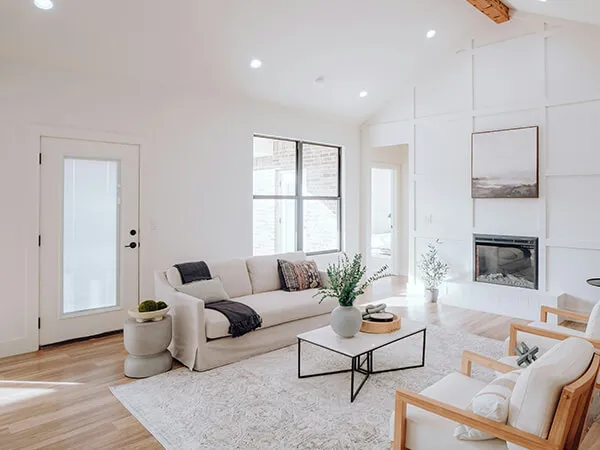
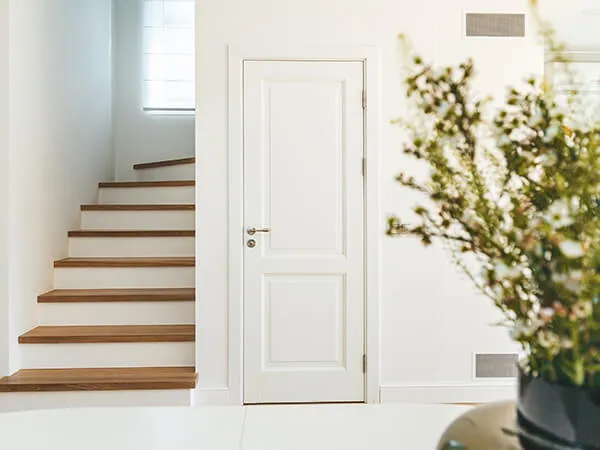
Panel Door
You can likely guess that panel doors consist of framed panels, starting with one or more, which are typically raised, flat, or recessed.
Most are made from solid wood, engineered wood, or composite materials, and they’re commonly found in bedrooms, bathrooms, and sometimes as entrance doors.
Hardy and substantial, panel doors provide impressive insulation and can provide a high level of soundproofing.
Whether used internally or externally, panel doors blend seamlessly into almost any home design.
Glazed Door
In much the same way, glazed doors need little explanation as they are exactly as described, with glass panels set within a frame.
They allow light to flood into living spaces, creating a sense of openness and a bright, airy atmosphere.
If you have a scenic view from your home that you’d like to make the most of, a glazed door is an ideal external choice, offering full appreciation of the outlook.
Glazed doors enhance natural light and visibility, and their versatility suits both traditional homes and modern styles alike.
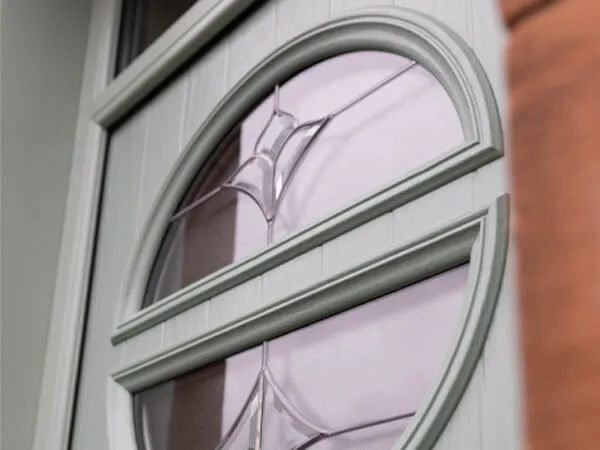
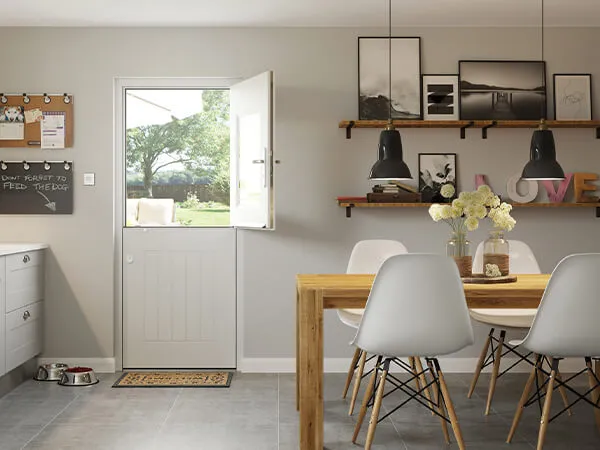
Stable Door
Stable doors are split into two halves, allowing each half to be opened or closed independently. This means you can let fresh air in by opening the top half while keeping the bottom half shut to stop young children or pets from wandering outside.
They are full of rural charm and, whether crafted from timber or featuring a wood-effect finish, are often chosen as back doors for their practical yet inviting appeal.
If you’re looking for a replacement door in a countryside residence or quaint cottage, stable doors could be the perfect fit.
French Door
Experience the undeniable sophistication of the French door, with its graceful, extended glass panels that stretch nearly the full height of the twin doors.
Designed to open either inwards or outwards, they create a wide, inviting entrance when you’re ready to move seamlessly from indoor comfort to outdoor enjoyment, such as stepping from your living room onto the patio.
Enhance the touch of refinement by opting for decorative glass inserts or stylish bars within the glazing.
French doors complement both classic and contemporary properties effortlessly.
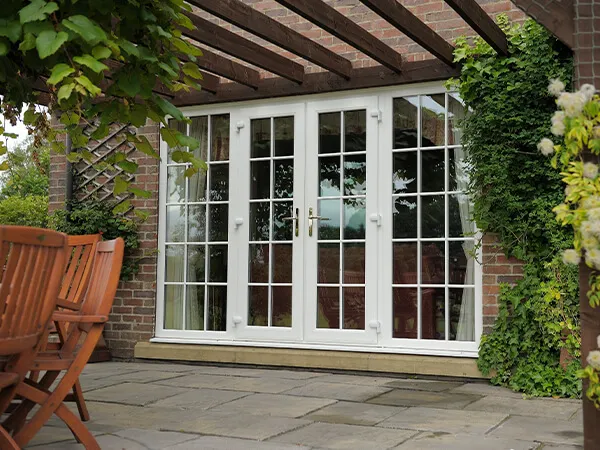

Fire Door
Fire doors are commonly installed between different areas of a building, such as corridors and staircases, to prevent the spread of fire in an emergency.
They are typically constructed from steel or specially treated woods, with each fire door assigned a fire rating to denote the degree of fire resistance it provides.
While ideal for townhouses and properties with an attached garage, fire doors are a valuable safety measure for any type of home.
Patio Door
A type of sliding glass door with large, expansive panes, the patio door is a popular choice for accessing gardens and letting natural light flood into the home.
Equipped with secure locking systems and mechanisms that meet British Security Standards, its slim sightlines ensure a clear, uninterrupted view when closed, so you can still enjoy the outdoors from inside.
In our opinion, any home with a bit of outdoor space would benefit from patio doors, making it easy to open up your property—whether it’s new or old—on a sunny day.
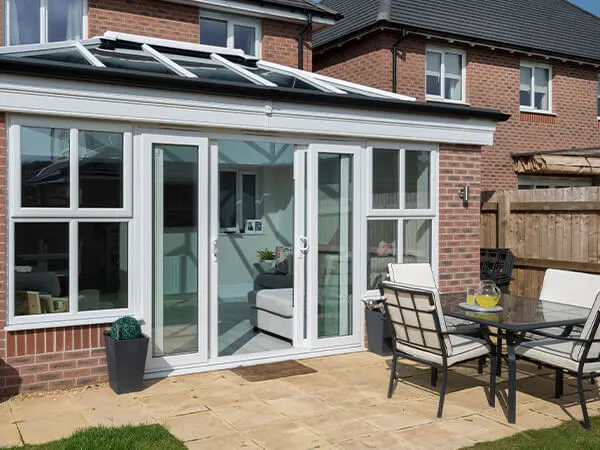
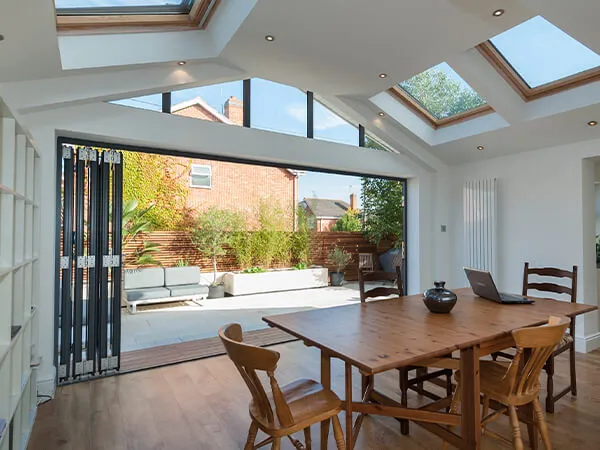
Bi-Fold Door
Bi-fold doors can span a large area, providing a generous opening for entertaining in the garden or welcoming fresh air and light into your home.
With a variety of configurations to choose from, you can easily personalise your bi-fold doors, deciding on the number of sections and the size that suits your space.
Seamlessly combining practicality with elegance, bi-folds glide open with just a light push, folding smoothly in a concertina-like manner.
You’ll often spot them in open-plan designs in modern homes, making them a great option to consider if you’re wondering whether they’ll complement your own property’s style.
Why Choosing the Right Door Material Matters
While it’s crucial to source a door that’s budget-friendly, efficient, and easy to upkeep, choosing the appropriate material is just as vital.
The material you select will impact every facet of the door’s functionality, including energy efficiency, resilience, safety, upkeep needs, lifespan, visual appeal, and longevity.
Remember this when assessing the different door options on the market.
The 4 Main Door Materials
UPVC
UPVC is a popular choice for both front and back doors, standing for Unplasticised Polyvinyl Chloride.
This material comes with a host of benefits. It’s incredibly durable, resisting weathering, corrosion, and rotting. Plus, it provides excellent thermal performance and some soundproofing, making your home more comfortable and energy bills lower.
You won’t have to worry about warping or fading over the years, so maintaining a UPVC door is a breeze—no need to repaint or touch up its colour every few years!
While it might not have the refined look of timber or aluminium, UPVC is the most budget-friendly option among today’s door materials.
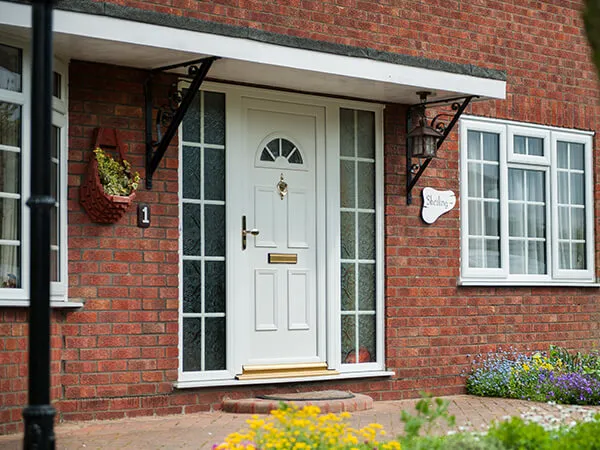
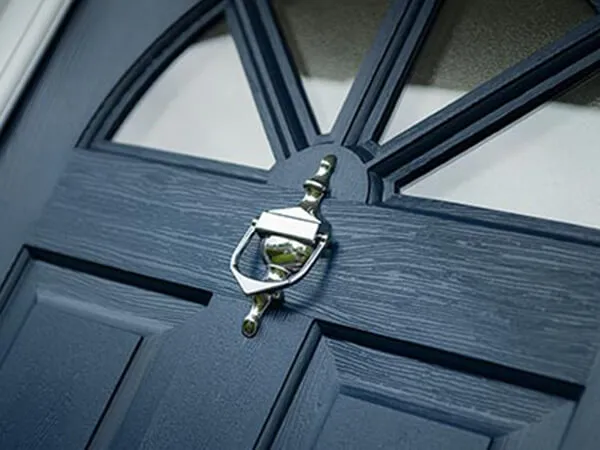
Composite
Glass-reinforced plastic (GRP) is one of the key materials used in a composite door frame, fused with UPVC, timber, and a foam core.
A composite door is one of the best front doors for security. This multi-layered design makes composite doors incredibly strong, making them a wise choice for a front door that offers around-the-clock protection for your home.
The outer glass-reinforced plastic layer is weather-resistant, so you won’t have to worry about unsightly cracks or warping in the frame.
You might easily confuse a composite door with a traditional timber one, as they look fairly similar, but a composite door offers much better security and requires far less maintenance than an old wooden door.
Aluminium
What surprises many people about aluminium is how lightweight it is, especially considering how incredibly strong it can be. Its flexibility is equally impressive, allowing it to be shaped into countless designs.
Aluminium doors are known for their sleek appearance and slim profile, which means the glazed sections can be quite expansive compared to doors made from other materials.
We’ve found that adding colour to aluminium works best through a multi-stage powder-coating process, resulting in a vibrant finish.
With proper care, aluminium can last for 40 years or even longer—now that’s durability you can count on!

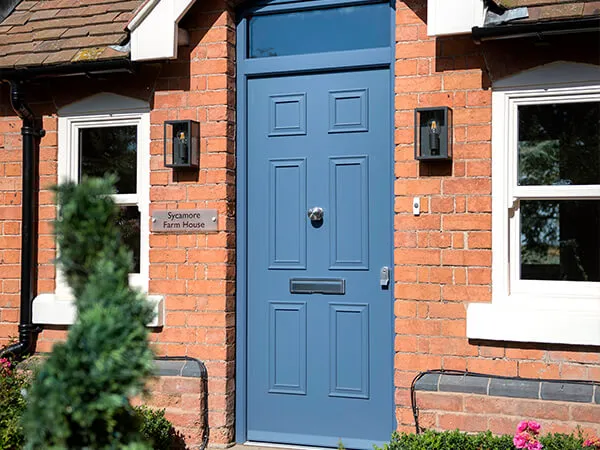
Timber
Responsibly sourced timber is eco-friendly, being both renewable and sustainable, while also radiating warmth and character.
Lower-grade timber can be susceptible to decay and rot due to exposure to the elements, making maintenance a bit of a chore. However, high-quality timbers are better equipped to withstand harsh conditions, which means less upkeep for you.
Timber’s versatility opens up endless possibilities for personalisation, allowing doors to be crafted into a wide variety of shapes and sizes to suit any property.
In addition to their charming appeal, timber doors offer impressive strength and durability, making them perfect for homes that require a timeless touch of elegance.
Request your free quote
Simply fill in your details for your free, no obligation quotation, and click "Get Quote"
Want to speak with an advisor? Give us a call on 0800 011 2400
Our friendly team will be pleased to help with any questions you may have.
